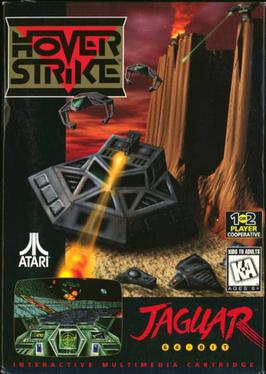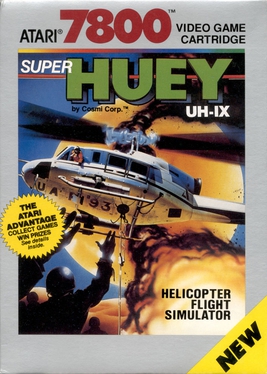
MicroProse is an American video game publisher and developer founded by Bill Stealey, Sid Meier, and Andy Hollis in 1982. It developed and published numerous games, including starting the Civilization and X-COM series. Most of their internally developed titles were vehicle simulation and strategy games.

Silent Service is a submarine simulator video game designed by Sid Meier and published in 1985 by MicroProse for the Apple II, Atari 8-bit computers, Commodore 64, and IBM PC compatibles, then ported to other home computers. A Nintendo Entertainment System version developed by Rare was published in 1989 by Konami in Europe and by Konami's Ultra Games subsidiary in North America. Silent Service II was released in 1990. Tommo purchased the rights to this game and published it online through its Retroism brand in 2015.

M1 Tank Platoon is a tactical simulator of tank warfare developed and published by MicroProse for the Amiga, Atari ST and MS-DOS in 1989. The game features a mixture of first-person, third-person tank warfare, and tactical simulation gameplay. It was followed by a sequel, M1 Tank Platoon II, released by MicroProse in 1998 for Windows. M1 Tank Platoon was sold to Interplay Entertainment in 2009. M1 Tank Platoon is available on Steam and Epic Games services.

Comanche is a series of simulation games published by NovaLogic, later THQ Nordic after their acquisition. The goal of each of these games is to fly military missions in a RAH-66 Comanche attack helicopter, which was in development and prototyping at the time of release.

Stunt Car Racer is a racing video game developed by Geoff Crammond. It was published in 1989 by MicroProse, under their MicroStyle and MicroPlay labels in the United Kingdom and in the United States, respectively. The game pits two racers on an elevated track on which they race in a head-to-head competition, with ramps they must correctly drive off as the main obstacle.

F-19 Stealth Fighter is a combat flight simulator developed and released in 1988 and 1990 by MicroProse, featuring a fictional United States military aircraft. It is the 16-bit remake of the 8-bit game Project Stealth Fighter, which was released for the Commodore 64 in 1987. It was also ported to the NEC PC-9801 in Japan only, and the DOS version was re-released on Steam distribution platform in 2015.

Gunship is a combat flight simulation video game developed and published by MicroProse in 1986. In the game, controlling a simulated AH-64 Apache helicopter, players navigate through missions to attack enemy targets and protect friendly forces. Commercially and critically successful, Gunship was followed by Gunship 2000 and Gunship!.

Magic Carpet is a 3D flying video game developed by Bullfrog Productions and published by Electronic Arts in 1994 for MS-DOS, PlayStation, and Sega Saturn platforms. Its graphics and gameplay were considered innovative and technically impressive at the time of its release.
Combat flight simulators are vehicle simulation games, amateur flight simulation computer programs used to simulate military aircraft and their operations. These are distinct from dedicated flight simulators used for professional pilot and military flight training which consist of realistic physical recreations of the actual aircraft cockpit, often with a full-motion platform.
The Falcon line of computer games is a series of simulations of the F-16 Fighting Falcon combat aircraft. The games, mostly published by Spectrum HoloByte, were noted for their high level of realism unseen in contemporary simulation games.

F-15 Strike Eagle is an F-15 Strike Eagle combat flight simulation game released for Atari 8-bit computers in 1984 by MicroProse then ported to other systems. It is the first in the F-15 Strike Eagle series followed by F-15 Strike Eagle II and F-15 Strike Eagle III. An arcade version of the game was released simply as F-15 Strike Eagle in 1991, which uses higher-end hardware than was available in home systems, including the TMS34010 graphics-oriented CPU.

Cybermorph is a shooter video game developed by Attention to Detail (ATD) and published by Atari Corporation as the pack-in game for the Atari Jaguar in North America on November 23, 1993, and Europe in June 1994. It was also distributed in Japan by Mumin Corporation as a stand-alone release. Taking place in a galactic war, the player pilots the morphing attack fighter TransmoGriffon to battle against the Pernitia empire, who have conquered planets on multiple sectors and whose regenerative robotic technology become entrenched into the planets. The player is tasked with recapturing critical pods, while facing against enemies and bosses, across five sectors in order to defeat the empire.

Steel Talons is a 3D combat flight simulator arcade game released by Atari Games in 1991. The player takes on the role of a pilot for an "AT1196 Steel Talons combat helicopter". Steel Talons was ported to the Sega Genesis, Atari Lynx, Atari Falcon, and the Super Nintendo Entertainment System. A Jaguar port was announced, but never released.

Hover Strike is a shooter video game developed and published by Atari Corporation exclusively for the Atari Jaguar first in North America in April 1995, then in Europe on May of the same year and later in Japan around the same period, where it was published instead by Messe Sansao. Taking place in a future where the Terrakian Pirates have seized control of a colonized foreign planet, players are tasked with piloting an armed hovercraft vehicle in an attempt of rescuing the captured colonists and obliterate the invading alien forces from the surface of the planet before the Federation armada arrives.

Knights of the Sky is a World War I combat flight simulator designed by Jeff Briggs and published by MicroProse in 1990 for MS-DOS. Ports to the Amiga and Atari ST followed in 1991.

Tinhead is a platform video game developed by Microprose U.K. and published by Ballistic and Spectrum HoloByte for the Sega Genesis.

Skyhammer is a shooter video game developed by Rebellion Developments and published by Songbird Productions for the Atari Jaguar on May 22, 2000. Its gameplay style is reminiscent of Psygnosis' G-Police for the PlayStation, which was released three years prior to the game.

Super Huey UH-IX is a helicopter combat flight simulation game published by Cosmi Corporation. Originally released for the Commodore 64 in 1985, it was ported to the Amiga, Apple II, Atari ST, Atari 8-bit computers, and MS-DOS. Atari Corporation published an Atari 7800 version in 1989.

Hellcat Ace is a 1982 combat flight simulator video game written by Sid Meier for Atari 8-bit computers and published by MicroProse as their first program. The game was an immediate hit and led Meier to write several new releases for the Atari home computers. Ports of Hellcat Ace were released for the Commodore 64 in 1983 and IBM PC compatibles in 1984.

Gunship! is a video game developed by the Hunt Valley studio at MicroProse and published by Hasbro Interactive for Windows in 2000. It's the third game in the Gunship series following Gunship (1986) and Gunship 2000 (1991). Hasbro announced in late 1999 that it would discontinue the development of military simulations. Gunship! was the last game in that genre from MicroProse.



















